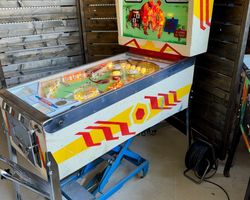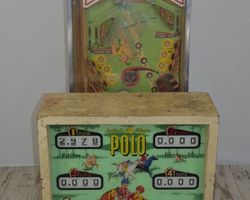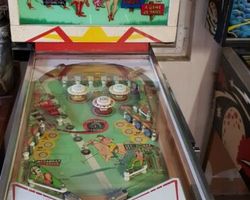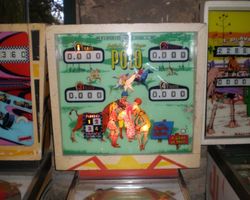Polo
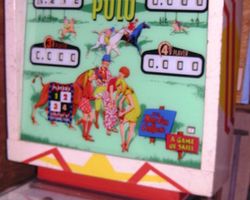
Average Prices: USD $300 to $700
Produced: January, 1970
Production Run: 1,140 units
Machine Type: Electro-mechanical
Players: 4
Design by: Ed Krynski
Art by: Art Stenholm
The Gottlieb "Polo" pinball machine, released in February 1970, emerges from an era when electro-mechanical (EM) games defined the pinball experience. Manufactured by D. Gottlieb & Co., a prominent name in the industry, "Polo" embraced a sophisticated sports theme, diverging from some of the more whimsical or sci-fi concepts common at the time. The inspiration behind "Polo" was to capture the elegance and dynamic action of the equestrian sport, translating it into a fast-paced, competitive pinball format.
The design and production of "Polo" were primarily overseen by Ed Krynski, a significant figure responsible for the game's overall concept, animation, and mechanical engineering. Krynski’s vision shaped the core gameplay and strategic elements that would define "Polo." The visual identity of the machine, crucial for attracting players, was crafted by Art Stenholm, whose distinctive artwork imbued the machine with a "warm" aesthetic, effectively conveying the theme. Production figures indicate that 1,140 units of "Polo" were manufactured, making it a moderately produced title for its time. An interesting facet of "Polo"'s history is its connection to other Gottlieb titles: its two-player counterpart, "Mini Cycle," shared a similar design philosophy, and its playfield layout was later adapted for the 1972 export model "Space Orbit," highlighting the efficiency and reusability of successful designs within Gottlieb's production pipeline.
Defining Design and Features
"Polo" is characterized by its early 1970s Gottlieb asymmetrical playfield design, a hallmark that distinguished many of the manufacturer's games during this period. This intentional imbalance in the playfield layout encouraged players to adapt their shotmaking, moving beyond symmetrical patterns to explore unique angles and carom opportunities. The artwork by Art Stenholm stands out, imbuing the backglass and playfield with rich colors and detailed depictions of the polo sport, from horses and riders in full gallop to classic country club scenery. This detailed artistic expression contributes significantly to the machine's overall appeal.
Central to "Polo"'s interactive elements are its electro-mechanical components. The game features two two-inch flippers, standard for EM machines of this era, which provide the primary means of ball control. These flippers, while smaller than those found in later solid-state games, demanded precision and timing from players. The machine's pop bumpers provide energetic ball movement and scoring opportunities, while slingshots positioned at the lower sides of the playfield rebound the ball, adding an element of unpredictability. The strategic engagement comes from a vari-target, a unique mechanism that registers different scores based on how hard it is hit, adding a layer of risk and reward. The authentic sounds generated by the EM relays, chimes, and solenoids further immerse the player, providing a tactile and auditory experience distinct to games of this vintage.
Playfield Layout and Mechanics
The "Polo" playfield, designed with an asymmetrical philosophy, presents players with a layout that encourages strategic shot selection over rote repetition. The two flippers are positioned conventionally at the bottom, offering control over the ball. Above the flippers, two slingshots on either side contribute to dynamic ball movement, often kicking the ball back into the flipper area or towards the upper playfield.
The upper playfield is where much of the scoring potential lies. Three pop bumpers are centrally located, providing chaotic yet satisfying bumper action as the ball ricochets between them. These bumpers are key to accumulating points and driving the ball into various target areas. Seven standup targets are strategically scattered across the playfield, demanding accurate shots to register hits and activate features. A standout element is the vari-target, which is critical for maximizing scores. Hitting this target with varying force allows for different point awards, encouraging players to control shot power. Another significant feature is the "Polo" kick-out hole, a critical objective for high scoring. Successfully navigating the ball into this hole often triggers substantial point awards, tying directly into the game's theme and primary scoring objective. The free ball return lane, a common Gottlieb feature, allows for a controlled return to the flippers, offering a brief reprieve and an opportunity to plan the next shot. The overall aesthetic of the playfield, with Stenholm's warm artistry and well-placed lighting, guides the player's eye to scoring opportunities and enhances the immersive quality of the gameplay.
Gameplay Dynamics
The gameplay experience of "Polo" is rooted in its electro-mechanical charm, emphasizing skill, shot accuracy, and a clear understanding of the scoring mechanisms. The primary objective revolves around a specific shot sequence designed to yield significant points. Players are encouraged to first target the vari-target. A well-executed shot to the vari-target is paramount, as it sets up the potential for higher scores. After striking the vari-target, the strategic aim shifts towards the "Polo" kick-out hole. Successfully dropping the ball into this hole, particularly after activating the vari-target, results in substantial point accrual, forming the core high-score strategy.
Beyond this primary sequence, "Polo" offers additional ways to score and stay in the game. The three pop bumpers contribute to general scoring and keep the ball in motion, while the seven standup targets offer multiple objectives for players to clear. A unique scoring mechanic involves the "outside is lit" condition: if the ball drains down an outlane while this feature is active, it can award significant bonus points, adding an element of risk-reward to desperate saves or unexpected drains. The game’s focus on direct, skillful shots to specific targets ensures that player strategy is rewarded. As a four-player machine, "Polo" fosters a competitive yet engaging multiplayer experience, making it a popular choice for group play. The combination of its clear objectives, satisfying scoring feedback, and the ability to challenge up to three other players contributes to a fun, repeatable play cycle that keeps players returning for "quick games."
Reception and Legacy
"Polo" has garnered a largely positive reception among pinball enthusiasts and collectors, particularly those who appreciate the nuances of electro-mechanical designs. Its strengths are frequently highlighted, beginning with the excellent asymmetrical playfield design, which offers a distinctive challenge compared to more symmetrical layouts of the era. Art Stenholm's artwork receives consistent praise for its "wonderful warm" quality, effectively conveying the polo theme and contributing to the machine's visual appeal. Many consider "Polo" to be among the better Gottlieb playboards from the early 1970s, a testament to its engaging design and playability.
Players appreciate the machine's enjoyable lights and authentic electro-mechanical sounds, which together create a captivating sensory experience characteristic of the period. The fun playstyle, particularly the strategic pursuit of the vari-target and the "Polo" hole, ensures that the game remains engaging. Its capacity for up to four players is a significant advantage, making it a popular choice for social gatherings and competitive play among friends. For individuals new to the world of EM pinball, "Polo" is often recommended as an approachable and rewarding entry point, demonstrating the charm and mechanics of these classic machines effectively. However, it is acknowledged that "Polo" is rarely encountered in the wild, suggesting its relative scarcity in the current market. While generally well-regarded, some experienced players might find its gameplay "okay" compared to more complex solid-state machines, but this minor point does not detract from its overall strong positive sentiment. "Polo"'s legacy is solidified by its solid design, its connection to Gottlieb's "Mini Cycle" and "Space Orbit," and its enduring appeal as a quintessential early 1970s Gottlieb EM machine.
Sponsored Links
 Ebay Listings
Ebay Listings
 Auction Results
Auction Results
| Cost | Location | Date |
|---|---|---|
| EUR €452 |  Nordrhein-Westfalen, Germany Nordrhein-Westfalen, Germany |
11 April, 2025 |
| EUR €500 |  Nordrhein-Westfalen, Germany Nordrhein-Westfalen, Germany |
23 June, 2024 |
| EUR €500 |  Nordrhein-Westfalen, Germany Nordrhein-Westfalen, Germany |
06 June, 2024 |
| EUR €1,100 |  Baden-Württemberg, Germany Baden-Württemberg, Germany |
22 September, 2020 |
| GBP £795 |  United Kingdom United Kingdom |
30 October, 2019 |
| USD $300 |  North Carolina, United States North Carolina, United States |
10 June, 2018 |
| EUR €699 |  Bayern, Germany Bayern, Germany |
18 September, 2014 |
| USD $275 |  New Jersey, United States New Jersey, United States |
24 October, 2013 |
| EUR €298 |  Niedersachsen, Germany Niedersachsen, Germany |
02 October, 2011 |
| EUR €136 |  Baden-Württemberg, Germany Baden-Württemberg, Germany |
17 August, 2011 |


Private Policy · Search Website · Contact Us
As an eBay Partner, we may earn a commission from qualifying purchases made through links on this site, at no additional cost to you.
All trademarks and copyrighted materials remain property of their respective owners. All other content copyright 2007 - 2025 Pinpedia.

